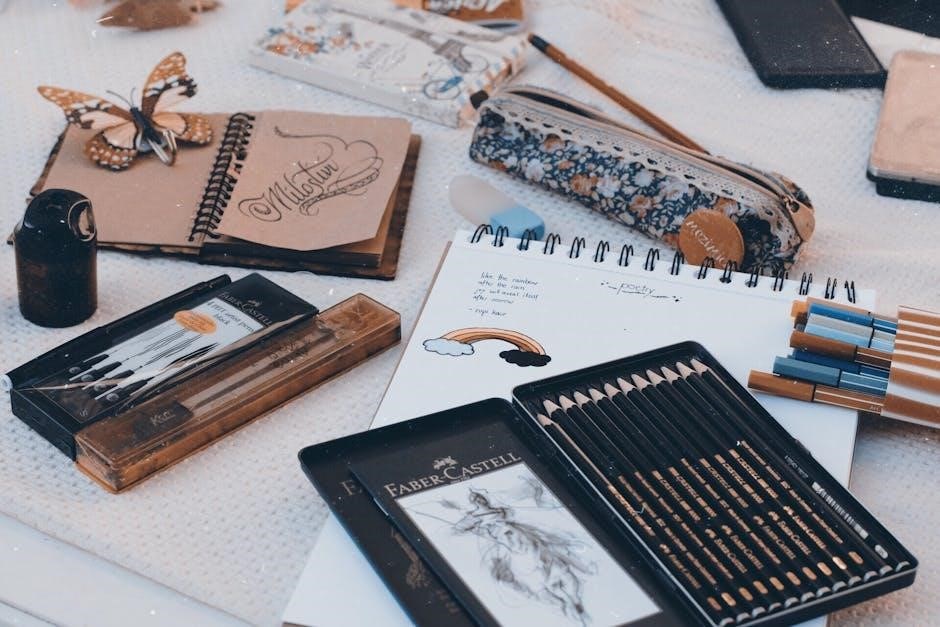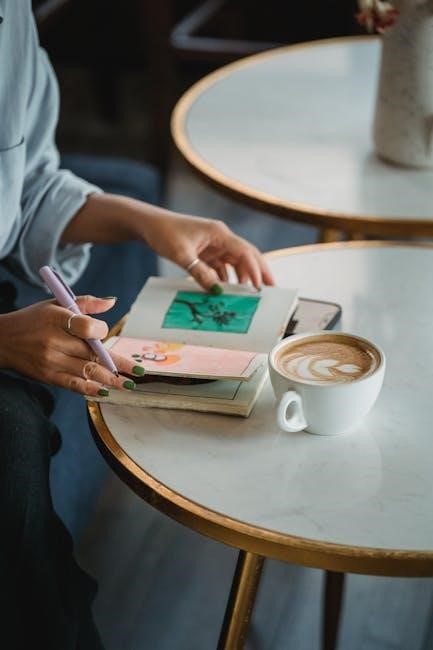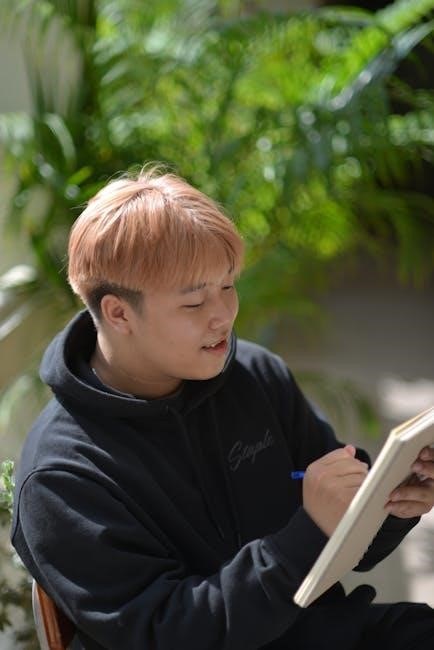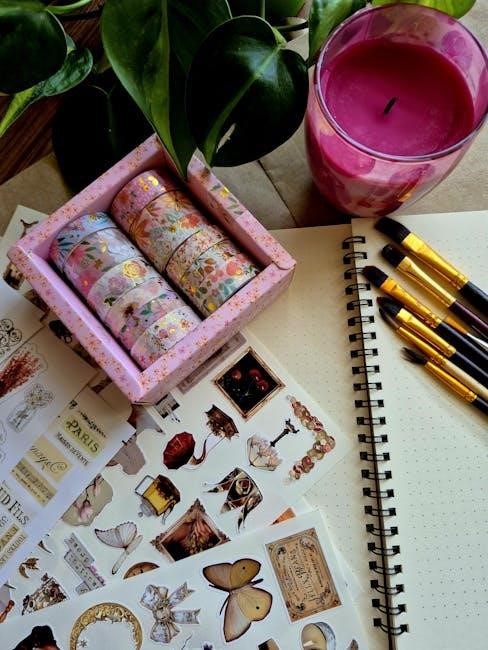
a short guide to writing about art sylvan barnet
Sylvan Barnet’s A Short Guide to Writing About Art offers practical advice for analyzing and interpreting art, covering observation, description, and critical analysis to enhance understanding and communication of artistic works․
The Importance of Writing in Art Studies
Writing is a cornerstone of art studies, as it enables students to articulate observations, analyze compositions, and interpret meanings․ Through writing, learners develop critical thinking and communication skills, essential for understanding art’s cultural, historical, and emotional contexts․ A Short Guide to Writing About Art emphasizes the importance of clear, concise expression to convey complex ideas effectively․ Writing about art fosters deeper engagement with artworks, encouraging students to move beyond surface-level descriptions to explore themes, styles, and artistic intentions․ This process not only enhances analytical abilities but also prepares students to present well-supported arguments in academic and professional settings, making writing a vital tool in the study and appreciation of art․
Sylvan Barnet’s Approach to Writing About Art
Sylvan Barnet’s approach to writing about art emphasizes clarity, precision, and engagement․ In A Short Guide to Writing About Art, he advocates for a structured, step-by-step method to help students articulate their thoughts effectively․ Barnet encourages writers to begin with careful observation, followed by detailed description and analysis․ He stresses the importance of avoiding vague language and focusing on specific elements like color, composition, and symbolism․ Barnet also highlights the value of personal response, urging writers to connect their analysis to broader themes or emotional resonance․ His approach is designed to demystify art writing, making it accessible while fostering critical thinking and creativity․
Structure of the Guide
The guide is structured to provide a comprehensive yet accessible approach to writing about art․ It begins with foundational concepts like observation and description, progressing to analysis, comparison, and research․ The text is divided into clear sections, each addressing specific aspects of art writing, such as formal analysis, stylistic identification, and exhibition reviews․ Practical advice on essay exams, research papers, and revisions is also included․ Barnet’s guide is designed to build skills incrementally, offering detailed examples and tips to help writers refine their craft․ Its logical organization ensures that readers can navigate easily, making it an invaluable resource for students and enthusiasts alike․

Key Elements of Art Analysis
Observation involves noticing details, while description translates visuals into words․ Analysis interprets meaning, connecting elements to themes, providing a deeper understanding of the artwork․
Observation: The Foundation of Art Writing
Observation is the cornerstone of writing about art, requiring careful attention to detail․ It involves actively engaging with the artwork, noting elements like color, composition, and texture․ Train your eye to slow down and truly see, rather than just glance․ Sylvan Barnet emphasizes the importance of systematic observation, suggesting tools like checklists or sketches to ensure thoroughness․ This step is crucial as it forms the basis for all subsequent analysis․ Effective observation helps you move beyond surface-level impressions, allowing you to uncover subtle details that might otherwise go unnoticed․ It fosters a deeper connection with the artwork and prepares you to interpret its meaning more accurately․ Over time, this skill becomes second nature, enhancing your ability to analyze and write about art with precision and insight․
Description: Translating Visuals into Words
Description is the process of translating visual elements into words, serving as a bridge between observation and analysis․ It involves creating a clear, concise, and accurate representation of the artwork․ Sylvan Barnet stresses the importance of using precise language to describe what you see, avoiding vague terms․ Focus on specific details such as shapes, colors, textures, and spatial relationships․ Use descriptive language to convey the artwork’s physical appearance without interpreting its meaning․ This step requires practice, as it demands balancing objectivity with engaging writing․ A well-crafted description provides a solid foundation for deeper analysis, allowing readers to visualize the artwork and understand your subsequent interpretations․ Over time, this skill enhances your ability to communicate complex visual ideas effectively․
Analysis: Moving Beyond Surface-Level Descriptions
Analysis involves interpreting the artwork, moving beyond mere description to explore its deeper meanings and significance․ Sylvan Barnet emphasizes the importance of engaging with the artwork’s themes, symbolism, and emotional resonance․ This step requires critical thinking and the ability to connect visual elements to broader ideas or contexts․ Analyze how the artist conveys messages, evokes emotions, or challenges perceptions․ Consider the cultural, historical, or personal contexts that shape the work․ Effective analysis involves asking questions about the artwork’s purpose and using evidence from the piece to support your interpretations․ This process transforms description into meaningful insight, enabling a richer understanding of the artwork’s impact and relevance․ Over time, analysis becomes a powerful tool for communicating your unique perspective on art․

Formal Analysis and Style
Formal analysis focuses on an artwork’s visual elements, such as line, shape, and color, while style refers to the artist’s unique approach or adherence to a movement․
Understanding Formal Elements (Line, Shape, Color, etc․)
In analyzing art, formal elements such as line, shape, color, texture, and composition are essential․ Line can define form or suggest movement, while shape creates mass and structure․ Color communicates mood and emotion, with warm hues evoking energy and cool tones calmness․ Texture adds tactile quality, either real or implied․ Composition refers to how these elements are arranged to guide the viewer’s eye․ By examining these formal elements, writers can uncover how artists create balance, harmony, or tension․ Barnet emphasizes that understanding these components is crucial for meaningful art analysis, as they form the visual language of the artwork․
Identifying Artistic Styles and Movements
Artistic styles and movements are crucial for contextualizing a artwork․ Styles reflect the artist’s intent, techniques, and cultural background, while movements represent broader artistic trends․ For example, Renaissance art emphasizes realism and perspective, whereas Impressionism focuses on light and immediacy․ Barnet suggests that identifying these elements helps in understanding the artwork’s historical and creative context․ By recognizing styles, writers can connect the piece to its artistic tradition and explore how it conforms to or challenges established norms․ This step enriches analysis by situating the artwork within a larger narrative, revealing its significance and the artist’s contribution to their era․ Precision in identifying styles enhances the depth of art writing․
The Role of Composition in Art
Composition is the backbone of a artwork, determining how elements are arranged to create harmony and balance․ Barnet emphasizes that composition guides the viewer’s eye, directing attention to focal points․ Principles like symmetry, asymmetry, and rhythm are essential, as they convey meaning and evoke emotions․ A well-structured composition can transform a simple subject into a compelling narrative․ By analyzing composition, writers uncover the artist’s intent and the artwork’s emotional impact․ Barnet suggests that understanding composition reveals how formal elements work together to create a unified whole, making it a critical aspect of art analysis and appreciation․

Developing Analytic Thinking
Barnet encourages writers to engage deeply with art by asking probing questions and exploring underlying meanings․ This fosters critical analysis and insightful connections to broader themes․
Asking Questions About the Artwork
Sylvan Barnet emphasizes the importance of asking questions to deepen understanding․ Start by inquiring about the artwork’s subject, composition, and emotional impact․ Consider the artist’s intent, cultural context, and symbolic elements․ Ask how formal elements like color or line contribute to the overall mood․ Question the relationships between figures or objects and their spatial arrangement․ These inquiries help uncover layers of meaning and guide analysis․ By asking “why” and “how,” writers move beyond description to interpretation, fostering a more engaging and insightful discussion․ This process encourages critical thinking and connects the artwork to broader themes or ideas, enriching the analysis and making it more meaningful․
Connecting the Artwork to Broader Themes
Connecting the artwork to broader themes enhances its relevance and depth․ Sylvan Barnet suggests exploring how the piece reflects or challenges societal norms, cultural values, or historical contexts․ Consider the artwork’s role in addressing universal themes like identity, power, or morality․ Think about how it engages with artistic movements or philosophical ideas․ By linking the artwork to these larger frameworks, writers reveal its significance beyond its visual appeal․ This connection encourages readers to see the artwork as part of a larger conversation, bridging the gap between the specific and the universal․ Such analysis elevates the discussion, making the artwork more relatable and impactful․
Using Evidence to Support Your Analysis
Using evidence to support your analysis is crucial for a compelling argument․ Sylvan Barnet emphasizes the importance of grounding interpretations in specific details from the artwork․ This involves referencing elements like line, color, composition, and subject matter to validate your claims․ For example, describing how a particular use of chiaroscuro creates mood or how a repeated motif reinforces a theme․ Directly connecting your observations to the artwork ensures credibility and clarity․ Avoid vague statements; instead, use precise examples to illustrate your points; This approach not only strengthens your analysis but also engages readers by providing a clear, evidence-based perspective․ Effective use of evidence makes your argument persuasive and intellectually rigorous․

Writing Comparisons
Sylvan Barnet’s guide emphasizes comparing artworks to reveal insights․ Comparisons highlight similarities, differences, and artistic intentions, enriching understanding through structured analysis․
Choosing Works of Art for Comparison
When selecting artworks for comparison, focus on pieces that share thematic, stylistic, or historical connections․ Barnet suggests choosing works that provoke meaningful contrasts or alignments, ensuring a productive dialogue․ Consider artworks from the same artist, movement, or period to highlight stylistic evolution or shared themes․ Alternatively, compare works across different styles or eras to reveal broader artistic or cultural trends․ The key is to select pieces that offer rich points of comparison, enabling deeper insights into artistic intentions and cultural contexts․ This thoughtful selection ensures your analysis is both focused and revelatory, aligning with Barnet’s emphasis on purposeful and insightful comparison․
Highlighting Similarities and Differences
When comparing artworks, it is essential to systematically highlight both similarities and differences to uncover deeper insights․ Start by identifying shared elements, such as composition, color palette, or subject matter, and explain how these contribute to the works’ overall impact․ Next, explore differences in technique, style, or interpretation, as these often reveal unique artistic intentions․ Use specific examples to illustrate these points, ensuring your analysis is thorough and nuanced․ Barnet emphasizes the importance of clarity and precision, urging writers to avoid vague generalizations․ By carefully balancing similarities and differences, you create a rich, comparative analysis that enhances understanding of the artworks and their contexts․
Interpreting the Significance of Comparisons
Interpreting the significance of comparisons between artworks is crucial for understanding their deeper meanings and connections․ By analyzing similarities and differences, you can uncover patterns, influences, or contrasts that reveal artistic intent or cultural context․ Barnet suggests that comparisons should go beyond surface-level observations, exploring how they reflect themes, styles, or historical movements․ This interpretation enriches your analysis by showing how artworks relate to one another and to broader artistic traditions․ It also allows you to evaluate the unique contributions of each piece while identifying shared human experiences or artistic goals․ Ultimately, interpreting comparisons deepens the reader’s appreciation of the artworks and their cultural significance․

The Research Paper
A research paper in art studies requires careful planning, in-depth analysis, and thorough documentation․ Barnet emphasizes the importance of original ideas, credible sources, and clear organization to effectively explore artistic themes and historical contexts․
Generating Ideas for Your Research
Generating ideas for your research in art studies begins with observation and curiosity․ Sylvan Barnet suggests starting by identifying a specific aspect of an artwork or artist that sparks your interest․ Consider the historical context, artistic movements, or emotional responses evoked by the piece․ Brainstorm questions about the artwork’s purpose, techniques, or cultural significance․ Use these questions as a foundation for your research․ Additionally, explore connections between the artwork and broader themes, such as societal trends or personal experiences․ Barnet emphasizes the importance of narrowing your focus to ensure depth and clarity in your analysis․ This process helps transform initial observations into meaningful and engaging research topics․
Conducting Effective Research
Conducting effective research for art writing involves gathering credible sources and organizing information thoughtfully․ Sylvan Barnet recommends consulting art historical texts, exhibition catalogs, and scholarly articles to build a well-rounded understanding․ Start by identifying key themes or questions related to your topic, then explore relevant sources systematically․ Take detailed notes and cross-reference ideas to ensure accuracy․ Evaluate sources for credibility, focusing on peer-reviewed materials and primary documents․ Barnet also suggests analyzing how different authors interpret the same artwork, as this can deepen your understanding․ Effective research requires patience, critical thinking, and the ability to synthesize diverse perspectives into a coherent narrative․ This process ultimately enriches your analysis and strengthens your argument․
Organizing Your Research Paper

Organizing your research paper effectively ensures clarity and coherence in presenting your ideas․ Sylvan Barnet suggests starting with a clear introduction that states your thesis and outlines the essay’s scope․ The body should be divided into focused paragraphs, each addressing a single idea supported by evidence from your research․ Use topic sentences to guide each paragraph, and ensure smooth transitions between ideas․ The conclusion should summarize key points without introducing new information, ending with a strong final statement․ Barnet emphasizes maintaining a logical flow and using visual elements like headings to enhance readability․ Proper organization helps convey your analysis persuasively and makes your argument easy to follow․

Review of an Exhibition
A review of an exhibition critiques and engages the viewer, offering insights into the artwork’s presentation and impact․
Preparing to Write About an Exhibition
Preparing to write about an exhibition involves thorough observation and research․ Visit the exhibition multiple times to absorb the artwork and its context․ Take detailed notes on the pieces, their arrangement, and the overall atmosphere․ Understand the curator’s intent and themes․ Research the artists, their styles, and the historical background of the works․ Review any provided materials, such as catalogs or wall labels, for additional insights․ Organize your thoughts by identifying key themes, standout pieces, and how the exhibition cohesively presents its message․ This preparation ensures a well-rounded and insightful review․
Describing and Analyzing the Exhibition
When describing and analyzing an exhibition, focus on capturing the essence of the artworks and their collective impact․ Use vivid language to convey the visual and emotional qualities of the pieces, such as color, composition, and texture․ Analyze how the works relate to one another and the exhibition’s overarching theme․ Consider the curator’s vision and how the arrangement of artworks enhances or challenges this narrative․ Evaluate the strengths and weaknesses of the exhibition, discussing standout pieces and their significance․ Use formal analysis techniques to examine individual works, connecting them to broader artistic movements or cultural contexts․ This approach ensures a balanced and insightful critique․
Evaluating the Overall Impact
Evaluating the overall impact of an exhibition involves assessing how effectively it communicates its theme and engages the audience․ Consider the cohesion of the artworks, the curator’s intent, and the viewer’s emotional and intellectual response․ Use formal analysis to evaluate the exhibition’s strengths, such as the quality of the works, their arrangement, and how well they convey a unified message․ Discuss weaknesses, like lack of focus or poor curation, and provide evidence-based examples․ Reflect on whether the exhibition challenges perceptions or provokes thought, and its relevance to broader cultural or artistic conversations․ A well-crafted evaluation offers a balanced critique, highlighting the exhibition’s ability to inspire and inform, ensuring a lasting impression on the viewer․

Essay Examinations
Essay examinations require analyzing works of art, comparing styles, and discussing historical contexts․ They demand clear, concise responses, applying critical thinking and art historical knowledge effectively under time constraints․
Understanding the Exam Question
Understanding the exam question is crucial for crafting relevant and focused responses․ Begin by carefully reading and breaking down the question to identify key terms and requirements․ Recognize whether the question asks for analysis, comparison, or interpretation․ Ensure clarity on what specific aspects of the artwork or topic are being addressed․ Avoid overcomplicating the question; instead, focus on its core demands․ Common exam questions may request comparisons between styles, analysis of themes, or discussions of artistic movements․ Always align your answer with the question’s parameters to stay on track․ Precision and conciseness are vital in exam settings where time is limited․
Structuring Your Essay Under Time Pressure
Structuring your essay under time pressure requires efficiency and clarity․ Begin with a concise outline to organize your thoughts, ensuring a logical flow from introduction to conclusion․ Allocate specific time segments for each section to maintain balance․ Start with a strong thesis statement that addresses the exam question directly․ Use clear topic sentences for each paragraph, supporting them with relevant evidence or examples․ Prioritize analysis over description to demonstrate deeper understanding․ Conclude by summarizing key points without introducing new ideas․ Practice outlining and writing under timed conditions to build confidence and speed․ Stay focused, avoid tangents, and ensure your essay remains coherent and responsive to the question․
Providing Clear and Concise Answers
Providing clear and concise answers is essential for effective communication in art essays․ Begin by understanding the question thoroughly and addressing it directly․ Use straightforward language, avoiding unnecessary jargon or overly complex sentences․ Focus on the key points and avoid tangents that do not contribute to the answer․ Ensure your response is well-organized, with each paragraph building logically on the previous one․ Use specific examples and analysis to support your points, demonstrating a deep understanding of the topic․ Finally, review your answer to ensure it is free of ambiguity and clearly addresses all parts of the question․ Clarity and precision are vital for making your arguments compelling and easy to follow․

Revising Your Work
Revising your work is crucial for refining ideas and ensuring clarity․ Sylvan Barnet suggests reviewing your writing to strengthen arguments and enhance the overall quality of your art analysis․
The Importance of Revision
Revision is a critical step in refining your writing about art․ It allows you to revisit your analysis, ensuring clarity and precision․ Sylvan Barnet emphasizes that revision is not merely about correcting errors but about enhancing the quality of your ideas․ By revising, you can strengthen your arguments, refine your observations, and ensure your writing effectively communicates your understanding of the artwork․ This process also helps you identify gaps in your analysis and align your writing more closely with the artist’s intent․ Ultimately, revision transforms a rough draft into a polished piece, making your insights more impactful and your writing more engaging for readers․
Editing for Clarity and Precision
Editing is essential to refine your writing, ensuring it is clear and precise․ Sylvan Barnet highlights the importance of clear language in conveying complex artistic ideas effectively․ Editing involves trimming unnecessary words, tightening sentences, and eliminating jargon that might confuse readers․ It also ensures your descriptions of artworks are vivid yet accurate, avoiding vague terms․ By focusing on clarity, you help readers grasp your analysis without losing the essence of your argument․ This process strengthens your writing, making it more engaging and accessible․ Barnet emphasizes that precise language is key to conveying your insights about art, ensuring your writing resonates with clarity and purpose․
Seeking Feedback
Seeking feedback is a crucial step in refining your writing about art․ Sylvan Barnet emphasizes the value of peer and instructor reviews to identify strengths and areas for improvement․ Feedback provides fresh perspectives, helping you clarify your ideas and strengthen your analysis․ When receiving feedback, consider how it aligns with your arguments and use it to refine your writing․ Barnet suggests being open to constructive criticism, as it enhances your ability to communicate complex artistic concepts effectively․ By incorporating feedback, you can produce more polished and impactful writing that resonates with readers․ This collaborative process is essential for growth as a writer and thinker in art studies․
This guide provides a comprehensive approach to writing about art, emphasizing observation, description, and analysis․ By mastering these skills, writers deepen their understanding and appreciation of art;
Summarizing Key Takeaways
In A Short Guide to Writing About Art, Sylvan Barnet emphasizes the importance of observation, description, and analysis in art writing․ He advocates for clear, concise language and the avoidance of jargon․ The guide underscores the value of connecting artworks to broader cultural, historical, or thematic contexts․ Barnet also highlights the significance of formal elements like line, shape, and color in understanding artistic styles and compositions․ By encouraging writers to ask questions and use evidence, the guide fosters critical thinking and analytical skills․ Ultimately, Barnet’s approach equips readers with the tools to write thoughtfully and effectively about art, bridging the gap between visual and verbal expression․
The Ongoing Process of Learning to Write About Art
Writing about art is a continuous learning process that evolves with practice and exposure to diverse artistic perspectives․ Sylvan Barnet’s guide encourages writers to embrace this journey, emphasizing that improvement comes through consistent effort and refinement․ As one engages with more artworks and critiques, their ability to observe, describe, and analyze deepens․ Revision and feedback are integral to this growth, helping writers clarify their ideas and express them more effectively․ The process fosters not only better writing but also a heightened appreciation for art․ By remaining open to new insights and challenges, writers can continually enhance their skills and contribute meaningfully to art discourse․
The Impact of Effective Writing on Art Appreciation
Effective writing about art enhances appreciation by bridging the gap between visual experience and verbal expression․ When writers articulate their observations and analyses clearly, they enable others to engage more deeply with the artwork․ Sylvan Barnet’s approach encourages writers to think critically and communicate insights persuasively, fostering a broader understanding of art․ By translating visual elements into words, writers help others see and interpret artworks in new ways․ This process not only enriches individual experiences but also contributes to a shared cultural dialogue․ Ultimately, effective writing about art makes it more accessible and meaningful, inspiring a greater appreciation for its power and significance․

